

Set Member Index Example (MIndex) This involves use of the 'Member Index (MIndex)' component from the 'Sets' tab.
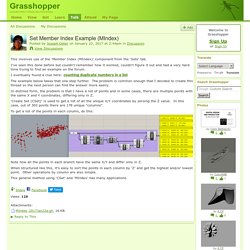
I've seen this done before but couldn't remember how it worked, couldn't figure it out and had a very hard time trying to find an example on the forum. I eventually found a clue here: counting duplicate numbers in a list The example below takes that one step further. The problem is common enough that I decided to create this thread so the next person can find the answer more easily.
In distilled form, the problem is that I have a list of points and in some cases, there are multiple points with the same X and Y coordinates, differing only in Z. 'Create Set (CSet)' is used to get a list of all the unique X/Y coordinates by zeroing the Z value. Cross Reference; what is it, how does it work, why would I need it? As of Grasshopper 0.9 components no longer offer a Cross Reference option in their pop-up menus.
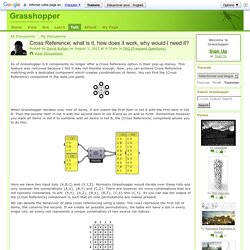
This feature was removed because I felt it was not flexible enough. Now, you can achieve Cross Reference matching with a dedicated component which creates combinations of items. You can find the [Cross Reference] component in the Sets.List panel. Min & max on grafted list. The top definition has 3 points, with 3 different distance components to make 3 independent lists, which I can then plug into extremes to get a new list based on minimums and maximums. however, the bottom definition has the 3 points all referenced into one point component (more convenient for a lot of points)and is grafted, then is using one distance component with the sq grid points, essentially creating the same 3 lists as the other definition due to list matching ( the beauty of GH), but they themselves live in a list. my question is how can i then obtain a new minimum or max value list from those 3 lists without using explode tree and then plugging into extremes.
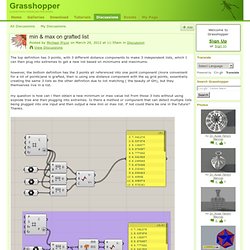
Is there a method or component that can detect multiple lists being plugged into one input and then output a new min or max list. if not could there be one in the future? Collecting outside points. Incremental 3d Convex Hull. Thanks to some theory on I managed to script an incremental 3d convex hull algorithm.

This is a part of "in-progress" script for k-means rationalization. It's quite fast (1000 points in cloud = 1.1 sec, amd x6), accepts multiple branches/hulls, most complex math operation is sqrt(2) :) , and its really simple to use (one input, one output) ;) Tags: 3d, convex, hull, incremental ▶ Reply to This. Relative tree item. ● !!
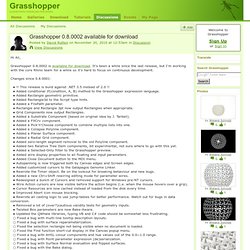
This release is build against .NET 3.5 instead of 2.0 !! ● Added conditional If(condition, A, B) method to the Grasshopper expression language. ● Added Rectangle geometric primitive. ● Added Rectangle3d to the Script type hints. Multiple attractor points in a circles grid. How can I sort in two dimensions? 2d-sort.ghx This file shows the basic idea of 2D sorting.
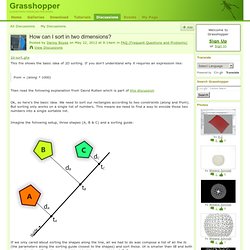
Unevenly divided surface. Path Mapper Help. As a result of a request please find a series of examples for using the Path Mapper component.
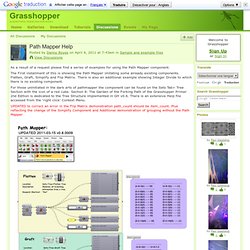
The First installment of this is showing the Path Mapper imitating some already existing components. Flatten, Graft, Simplify and Flip Matrix. There is also an additional example showing Integer Divide to which there is no existing component. For those uninitiated in the dark arts of pathmapper the component can be found on the Sets Tab> Tree Section with the icon of a red cube. Section 8: The Garden of the Forking Path of the Grasshopper Primer 2nd Edition is dedicated to the Tree Structure implemented in GH v0.6. UPDATED to correct an error in the Flip Matrix demonstration path_count should be item_count. Updated: 2011-04-20 Replace Branches Not sure if it's right to include this here as its actually encouraging you not to use the Path Mapper, but sometimes there are benefits to being able to keep the definition free from restrictions like the Path Mapper.
Display full numbers. List components with levels. Hi everyone I have thought a little about this and I don't see why not, so here it is.

A while ago I had this configuration: 0;0;0 {a,b,c,d} 0;0;1 {e,f,g,h} 0;0;2 {i,j,k,l} 0;1;0 {m,n,o,p} 0;1;1 {q,r,s,t} 0;1;2 {v,w,x,y} A beta plug-in for rhino. MeshMash! As regular readers of this blog will know, I’m passionate about the use of relaxation and force-based methods for optimizing geometry in a very interactive way.
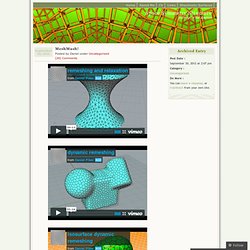
There is a great variety of form-finding that can be done by assigning physical forces as interactions between sets of particles. However, in my investigations so far, the topology of these interactions has usually remained fixed. So the overall shape changes dramatically, but the number of points -and the underlying network of which point interacts with which- remains the same throughout the simulation. I have written about topology optimization before, in my post on self organizing structures, but the videos above use a fundamentally different approach than any of the examples shown there, as this new work is based on purely local interactions, which reconfigure their connectivity as the geometry changes. edge flip.
SR22. Wb-like mesh faces offset with attractors. Mesh dynamic relaxation + attraction with Hoopsnake. Drainage Direction Script. I made a python script that estimates the direction of drainage paths on a surface.
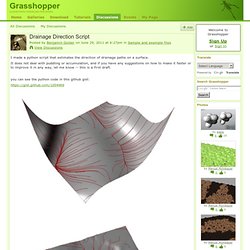
It does not deal with puddling or accumulation, and if you have any suggestions on how to make it faster or to improve it in any way, let me know -- this is a first draft. you can see the python code in this github gist: Tags: Attachments: drainScript.ghx, 218 KB. Template:Grasshopper Data Tree editing. Introduction Data Tree Grasshopper uses, in contrast to a programming environment, no object names to define an object. This may sound trivial but it one of the most fundamental differences from a traditional modelling environment.
In Grasshopper the object or objects are placed in a list. Shrink Wrap with Kangaroo. Closed Curves / Cells from arbitrary grid of Lines / Curves. Looping Problem. Hello, I am working on a project regarding the composition of tetrahedron at their adjacent faces to grow into a larger overall composite. My plan of action was originally for the geometry to mirror itself and grow to the set outcome (distance to point in Galapagos). Form. Skeletal mesh. In response to this discussion: I am posting my definition for generating an open foam mesh. (I didn't post back at the time because there were some troubles with weaverbird back then and I was having to use some ugly workarounds, but now that is all fixed) To sum up the approach - take a random cloud of points generate the 3d voronoi. Triangular morphing/mapping. Hi all, I've been playing around with something - trying to map an object from one triangular "space" to another - that is to do a sort of triangular cage edit...
Pretty much all of the morphing methods are based on rectangular structures (NURBS/UV), so it's somewhat difficult to find ways this can be done (without using mathematics that are above my grade-school level... :) ) I did mock up a way with a planar curve object and the MapToSurface module using base and target triangular surfaces made with either Edge Surface or 4Point Surface, but it doesn't seem to be extremely accurate - the more points the original has, the better it gets, but it's never really good. The idea is the base triangle just touches the object at 3 points (a "bounding triangle", for which I made my own quickie definition) and I want it to map to the target triangle(s) in the same way. A sort of triangular box morph. Mapping a shape between two triangles. Controlling longest list behaviour. Random Linear Growth – Hoopsnake « WeWantToLearn.net. Inside voronoi cells selection (test for duplicate points)
Hello i would like to select "skin cells" from voronoi body.